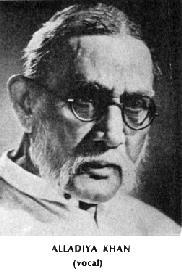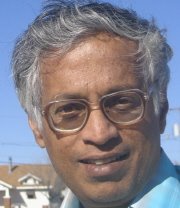
Alladiya Khan (1855-1946) is the founder of Jaipur-Atrauli gharana to which several modern titans belong. Born into a family of musicians in Atrauli (Rajasthan) he lost his father early. His uncle Jehangir Khan taught him dhrupad for 5 years and khayal for another 8. Until he was 25 Alladiya Khan learnt and practised music, occasionally performing but yet to take it up as profession. After initial success at Ajaygad court as singer, Alladiya Khan set off on a concert tour visiting Patna, Mujaffarpur, Allahabad, Calcutta and other places with successful recitals everywhere. His concert at Motihari resulted in an invitation by the king of Nepal, where the ustad spent two years until he felt homesick. Even during travel Alladiya Khan would not neglect music. He practised hard literally from dusk to dawn even at 51.
Alladiya Khan enjoyed royal patronage at several places. He was the court musician for the Kolhapur king, until the king died in 1922 and later moved to Bombay. At Amlata, he almost lost his voice due to hours of singing daily for a couple of years. His voice lost sweetness and he had to depend on taans. So he adopted a new style which helped him sing without compromising the purity of raga. His main disciples were his famous younger brother Haider Khan, Bhaskarbuwa Bakhale and his own sons. Khansaheb invariably started training with dhrupad-dhamar and took up khayal only after their voices stabilized and became tonally perfect. While the second son Manji Khan died in 1937, the youngest son Bhurji Khan continued to teach his father’s disciples like Kesarbai Kerkar. Among the others Mogubai Kurdikar (Kishori Amonkar‘s mother) learnt from Haider Khan while Mallikarjun Mansur learnt from Manji Khan and Bhurji Khan.
Alladiya Khan, who won the title Gana Samrat, represented what is considered by some a dissident branch of the Agra gharana. His style was in contrast to the rather straightforward Gwalior gharana. He was an artiste par excellence and knew thousands of compositions by heart and a collection of hundreds of rare ragas. Alladiya Khan developed taans that require exceptional voice control. He brought in the complexities of both dhrupad and khayal into his music. Though not as slow as Kirana gayaki, the varying note patterns provide the rhythm and enhance the characteristic relationship between the notes. He employed oblique alaps and taans without deviating from the chosen rhythm making fresh improvisations with accent on different beats during layakari. The intellectual style of presentation of traditional compositions pays a lot of attention to the beats of the taal as the first one (sam) is reached. The second stanza (antara) is usually omitted. Rare and composite ragas such as Sampurna-Malkauns, Basant-Kedar, Basant-Bahar, Kaunsi-Kanada and Nat-Kamod are preferred. In his time the ustad was revered by the likes of Bal Gandharva, Govindrao Tembe (harmonium artist), B.R.Deodhar and others while Bhatkhande considered his style of music his own and not handed down by his ancestors.
Alladiya Khan had a striking figure, tallish, somewhat spare frame, white moustache and whiskers. Like Maharashtrians, he wore snow-white dhoti, a spotless white shirt underneath an open collar dark jacket, a pink turban with a long tail, and slippers. He claimed his ancestors were Adya Gaud Brahmins who had to convert to Islam when the emperor in Delhi had obliged them by releasing their Hindu king from prison. He called himself Brahmin Muslim and therefore unfortunately, when he died after prolonged illness, other Muslims were too indifferent to attend his funeral in large numbers.
Followers of the gharana include Ashwini Bhide, Arati Ankalikar, Padma Tralwalkar, Padmavati Shaligram, Shruti Sadolikar, V R Kadnekar, Vinayakrao Kulkarni and others.




3 Comments:
Nice Article. These stories definitely help young generation understand the efforts and dedication involved in learning Hindustani Classical music. I would like to note that Mogubai Kurdikar learned from Alladiya Khansaheb (as well as Haider Khansaheb) --In fact she was most favorite student of his. Kishori Amonkar (Mogubai Kurdikar's daughter and disciple) and Dhondutai Kulkarni ( disciple of Bhurji Khan and Kesarbai Kerkar) are living icons of Alladiya Khansaheb's gharana.
SANGEET SAMRAT USTAD ALLADIYA KHANSAHEB OFFICIAL BLOG
http://www.ustadalladiyakhan.blogspot.com
By Nazarahmed Khan Grand Son Of Azizuddin khansaheb
You made such an interesting piece to read, giving every subject enlightenment for us to gain knowledge. Thanks for sharing the such information with us to read this... Ghana events
Post a Comment
<< Home